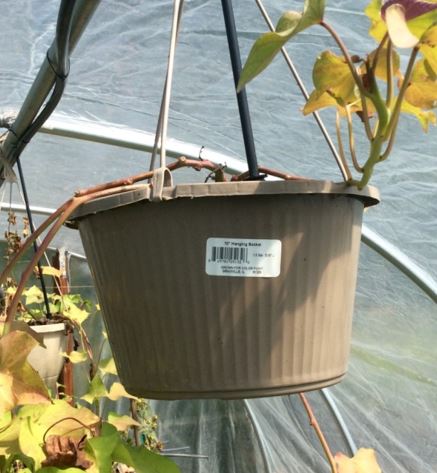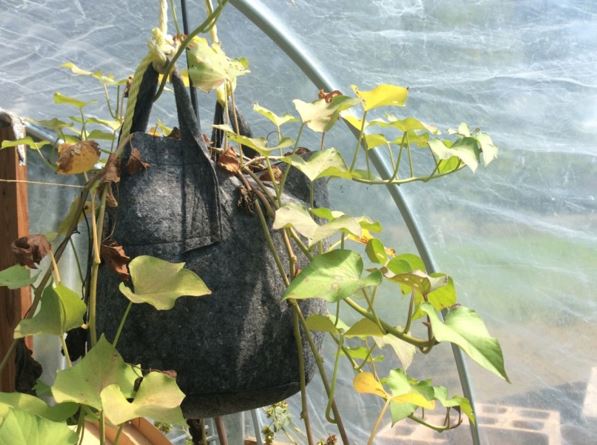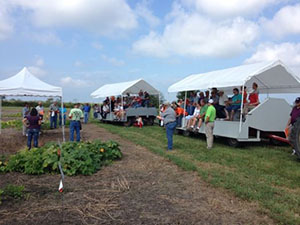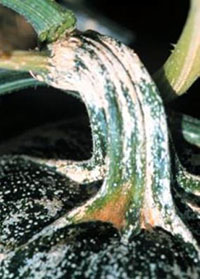Address any questions or comments regarding this newsletter to the individual authors listed after each article or to its editors, Nathan Johanning, 618-939-3434, njohann@illinois.edu or Bronwyn Aly 618-695-6060, baly@illinois.edu. The Illinois Fruit and Vegetable News is available on the web at: http://ipm.illinois.edu/ifvn/. To receive or be removed from email notification of new postings of this newsletter, contact Nathan Johanning or Bronwyn Aly at the phone numbers or email addresses above.
In This Issue:
Upcoming Programs (listings for beginning and established growers)
Regional Reports (north central, southern Illinois)
News and Announcements (NC SARE farmer/rancher grant)
Vegetable Production and Pest Management (How can we improve your experience with the pest degree day calculator, Plectosporium Blight on Pumpkins)
Upcoming Programs
Check the Illinois SARE calendar for a full list of programs and links for registration.
http://illinoissare.org/ and http://illinoissare.org/calendar.php
Also see the University of Illinois Extension Local Food Systems and Small Farms Team's website at:
http://web.extension.illinois.edu/smallfarm/ and the calendar of events at http://web.extension.illinois.edu/units/calendar.cfm?UnitID=629.
- Master Urban Farmer Training Program, Wednesdays, September 14 to November 16, 2016 6 – 9 pm. Prairie State College, Matteson Area Center, 4821 Southwick Drive, Matteson, IL 60443. The Master Urban Farmer Training Program is designed to provide new urban farmers in Cook County the introductory knowledge and skills to start an urban farm. The program fee is $150 and registration is opened until August 12. To register visit https://web.extension.illinois.edu/registration/?RegistrationID=14878. For more information contact Zack Grant, 708-679-6889, zgrant2@illinois.edu
- 7th National Small Farm Conference - Creating and Sustaining Small Farmers and Ranchers, September 20-22, 2016. Virginia Beach Convention Center, Virginia Beach, VA. For more information, call 804-524-5626 or email NSFC2016@vsu.edu
- Meet the Farmers, Meet the Buyer. Monday, October 10, 2016 10:00 AM to 5:00 PM (Doors open at 9:30 AM). St. Louis University campus in the II Monastero Building, 3050 Olive Street, St. Louis, Missouri This event is an opportunity for farmers to meet with buyers and learn what it takes to do business with the grocery and foodservice industries. To register visit http://www.ilfb.org/ifb-news-and-events/conferences-events/october-10,-2016-meet-the-buyer-event.aspx. For more information contact Cynthia Haskins, 309-557-2155; CHaskins@ilfb.org.
- Organic Soil-borne Disease Management Webinar. October 13, 2016 from Noon – 1pm. Contact Laurie George (ljgeorge@illinois.edu) or James Theuri (jtheu50@illinois.edu ). Preregistration required: https://web.extension.illinois.edu/registration/?RegistrationID=14944
- Illinois Specialty Crops, Agritourism, and Organics Conference, January 11-13, 2017. Crown Plaza, Springfield, IL. For more information, Illinois Specialty Growers Association, 1701 Towanda Ave., Bloomington, IL 61701. Phone 309/557-2107 FAX 309/557-3729 E-mail Cblary@ilfb.org.
- Ohio State University 2016 Direct Marketing Webinar Series. Noon (Eastern time). Take this opportunity to learn more about marketing issues. Recordings of all webinars can be found at www.go.osu.edu/DirectMarketingWebinars. Links below are for recording for previous webinars and connection links for future sessions.
- Feb. 18 Marketing Trends Learned from the Super Bowl Eric Barrett & Rob Leeds
- Mar. 2 Using All Your Senses in Branding Your Business Eric Barrett & Rob Leeds
- Apr. 21 Enhancing Your Web Presence Melissa Carter
- May 26 Product Recall & Traceability Eric Pawlowski
- June 16 Product Labeling Emily Adams
- July 21 Celebrate Ohio Local Foods Week Heather Neikirk & Patricia Barker
- Aug. 18 Produce Auctions http://carmenconnect.osu.edu/auctionsforproduce/ Brad Bergefurd
- Sept. 15 Pricing Your Products http://carmenconnect.osu.edu/pricingproducts/ Megan Leffew
- Oct. 20 Cooperatively Marketing Your Products http://carmenconnect.osu.edu/marketingyourproducts/ Hannah Scott
- Nov. 17 Using Facebook for Your Business http://carmenconnect.osu.edu/facebookforyourbusiness/ Duane Rigsby
- Dec. 15 Survey Results for Ohio Produce Marketers http://carmenconnect.osu.edu/surveyresultsformarketers/ Direct Marketing Team
Regional Reports
From north-central Illinois…The last week of August gave us almost 2.5 inches of rain and some much cooler temperatures. The break in the summer heat was short-lived. This past week has been reliably in the 90's. Irrigation in the high tunnel has been going every day.
Hops have been harvested, dried, and now packaged in the freezer. I am finally getting some color in our peppers. Personally, I don't bother with green peppers, preferring flavor as opposed to roughage.
The sweet potatoes have become unwieldy monsters, and I look forward to getting my high tunnel back after this little experiment. One good thing is sweet potatoes are very easily redirected back into their beds. The sweet potatoes in the hanging baskets are now fairing nearly as well as those in the various in-ground systems I have tried this year. The hanging plastic pots simply get too hot. The hanging fabric pot shows improved growth over the plastic, likely due to the breathability and larger volume for holding potting soil. Still no comparison to those growing in-ground.

Sweet potato in plastic hanging basket. The pot holds too little soil volume and heats up too much. Vegetative growth has been very poor. -- Photo by C. Enroth

Fabric hanging pot. You can see better vegetative growth. This is likely due to the larger soil volume and breathability of the fabric, allowing it to cool like a clay pot. -- Photo by C. Enroth

Still the hanging baskets fall way behind the vegetative growth of sweet potatoes growing in the various in-ground systems. -- Photo by C. Enroth
The only fall crops I'm growing this year are for personal use, but fall is my preference over spring for cool season crops. Here is my reminder to get those fall crops planted. It's tough to be thinking about harvests in December right now, but it is important to get the crop to harvestable size before sunlight hours diminish to the point of little or no growth occurring. For most crops, this is when daylight drops below ten hours. The intensity (which decreases as the sun angles farther south in the winter) along with the duration of sunlight are critical to plant growth. You can calculate what day that occurs on in your area at http://aa.usno.navy.mil/data/docs/Dur_OneYear.php.
Mosquito experts are saying growers and gardeners are at higher risk for infection of mosquito-borne illness due to our time outside doing rigorous physical activities. We tend to get lax late in the season when managing our farms for mosquito habitat, but mosquitoes are still active. A new invasive mosquito species Aedes japonicus will remain active until the first hard frost. All growers, especially those conducting agri-tourism operations should make sure to keep mosquito management part of your farm routine. Tasks that can reduce mosquito populations on your farm:
- Clean out and turn over any containers with standing water.
- Cover/screen any containers you cannot empty such as rain barrels, cisterns, irrigation tanks, etc.
- Make sure gutters are clean of debris and drain properly
- If you can't remove the standing water, then treat it with Bti (Bacillus thuringiensis israelensis). Bti only targets mosquito larva.
- Mosquitoes are weak flyers. Have fans moving air in places where customers tend to gather.
- Stock ponds with top-feeding minnows
- Avoid using bug zappers to control flying adults. About 90% of insects killed with bug zappers are not mosquitoes. In fact, several are beneficial insects like the brown lacewing.
- Mosquito foggers work for only a short period and are well-suited to being used before an outdoor event.
Chris Enroth (309-837-3939; cenroth@illinois.edu)
From southern Illinois ... Rain finally tapered off with really pleasant temperatures week before last. This week we are again experiencing hot, humid weather with temperatures in the upper 90's. A chance of more rain is possible later in the week. Wine grape harvest is nearly complete, with several reports of an excellent crop. Some strawberry plasticulture growers set transplants over the holiday weekend, taking advantage of drier conditions. For those interested in pricing information from farmers markets and produce auctions in IL, KY, TN, & WV, visit http://www.uky.edu/ccd/pricereports. The last couple of produce auction reports from Arthur, IL have listed average prices for several specialty pumpkins.
Bronwyn Aly (618-382-2662; baly@illinois.edu)
More from southern Illinois… The last week or so has actually been pleasantly dry (rainfall); however, the heat and humidity have been very summer-like with some very hot, humid days especially the first part of this week. We have had some breaks in the weather as last weekend turned out very pleasant, and the forecast for this weekend is also very good with a drop in humidity and temperatures around 80. Our "dry spell" has ended with a wave of thunderstorms coming through Thursday (9/8) afternoon which brought Murphysboro, 1.4" with more predicted for Friday and maybe Saturday in the morning. Hopefully, we will be transitioning to more "fall-like" temperatures, and with the fall agritourism season starting soon, it would be nice if the pleasant weekend weather would continue!

Attendees of the 2016 Pumpkin Field Day
on the field tour. Photo: N. Johanning
Out in the field, we are nearing the end of the season for peaches and also grapes with only a few varieties left still out. We are in the midst of apple season and so far things are looking pretty good. I picked up some 'Golden Supreme' from a local orchard last week. Pumpkin harvest is getting underway! Many early varieties have a good first set that is ripe. I would look to see many pumpkins and other fall décor to be showing up at local stands and markets over the next week or so if it is not out already. The impacts of the rains of July and August are still plaguing some pumpkin fields especially where drainage is an issue. Overall, I think fruit size is a little less on some jack o'lanterns this year and much of that I attribute to the weather. During pumpkin bloom, we have had multiple stretches of cloudy, rainy days which tends to limit our pollinator activity. Research has shown a direct relationship between the number of bee visits to a pumpkin flower and its size, with more bee visits giving larger fruit. Also, I think just the general stress on the plant from excessive soil moisture and then intense heat at times is probably also in play.
I would like to thank everyone that helped with and attended the 2016 Pumpkin Field Day at the Ewing Demonstration Center! We had over 100 in attendance from all across the state and neighboring states. Be looking for more information throughout the fall and winter months as we summarize the trials and share that information!
Nathan Johanning (618-939-3434; njohann@illinois.edu)
News and Announcements
NCR-SARE Announces 2017 Farmer Rancher Sustainable Agriculture Grants Call for Proposals
The 2017 NCR-SARE Farmer Rancher Grant Call for Proposals is now available! Farmers and ranchers in the North Central region are invited to submit grant proposals to explore sustainable agriculture solutions to problems on the farm or ranch. Proposals should show how farmers and ranchers plan to use their own innovative ideas to explore sustainable agriculture options and how they will share project results. Sustainable agriculture is good for the environment, profitable, and socially responsible. Projects should emphasize research or education/demonstration.
There are three types of competitive grants: individual grants ($7,500 maximum), team of two grants for two farmers/ranchers from separate operations who are working together ($15,000 maximum), and group grants for three or more farmers/ranchers from separate operations who are working together ($22,500 maximum). NCR-SARE expects to fund about 40 projects in the twelve-state North Central Region with this call. A total of approximately $400,000 is available for this program.
NCR-SARE will be accepting online submissions for the Farmer Rancher Grant Program. More information about the online submission system can be found in the call for proposals.
Interested applicants can find the call for proposals online as well as useful information for completing a proposal at http://www.northcentralsare.org/Grants/Types-of-Grants/Farmer-Rancher-Grant-Program. You can find more information about sustainable agriculture at http://www.sare.org/. Proposals are due on December 8, 2016 at 4 p.m. CST.
Potential applicants with questions can contact Joan Benjamin, Associate Regional Coordinator and Farmer Rancher Grant Program Coordinator, at benjaminj@lincolnu.edu or 573-681-5545 or 800-529-1342. Applicants should also contact Joan Benjamin if they need a hard copy or an email version of the call for proposals. We make revisions to our calls for proposals each year, which means it is crucial to use the most recent call for proposals.
Each state in SARE's North Central region has one or more State Sustainable Agriculture Coordinators who can provide information and assistance to potential grant applicants. Interested applicants can find their State Sustainable Agriculture Coordinator online at http://www.northcentralsare.org/State-Programs.
Vegetable Production and Pest Management
How can we improve your experience with the Pest Degree Day Calculator?
Insects require a certain amount of heat to develop from one stage in their life cycle to another (eggs to larvae to pupae to adults). Degree-days measure insect growth and development in response to daily temperatures. The accumulation of these degree-days can be measured over a period of time and used to estimate growth and predict insect development. Calculating degree-days allows us to predict when significant biological events such as the appearance of insect pests may occur or when they may reach a life stage that is damaging to a particular crop.
Fortunately, we have at our fingertips a calculator that can help us calculate degree-days for selected pests. The Pest Degree Day Calculator is a result of a collaborative scientific effort that combines daily weather data collected by the Water and Atmospheric Resources Monitoring (WARM) Program (Illinois State Water Survey, Prairie Research Institute, University of Illinois) and the Integrated Pest Management (IPM) Program (Department of Crop Sciences, University of Illinois) to provide daily, up-to-date information about pest and crop development in Illinois.
We are working hard to improve our Degree Day Calculator. Let us know what you like, don't like, or what you would like to see changed. Take our survey to share your thoughts: https://illinois.edu/sb/sec/1753389. Thanks in advance for your help! For more information about the degree day calculator, please contact Kelly Estes, State Survey Coordinator, ICAPSP, INHS, 1816 South Oak Street, Champaign, IL 61820
Kelly Estes, State Survey Coordinator, Illinois Cooperative Agricultural Pest Survey (217-333-1005; kcook8@illinois.edu)
Plectosporium Blight on Pumpkins

Plectosporium Blight on
a pumpkin fruit and stem.
Photo: University of Illinois
With all of the rains many pumpkin growers have seen an explosion of plectosporium blight across various parts of the state including southern Illinois. This disease causes small light tan lesions often seen first on leaf petioles and stems, but progressing to the stems of the fruit and the fruit itself. When severe this can completely defoliate and kill plants. The fruit and "stem" lesions are detrimental to the marketability of the fruit which is of significant concern. For more information and control measures visit the factsheet Plectosporium Blight of Cucurbits or consult the Midwest Vegetable Production Guide.
Nathan Johanning (618-939-3434; njohann@illinois.edu)
Less Seriously...
Going through some old books and papers from the Dixon Springs Agricultural Center, I came across a little book that I am guessing was Dr. Bill Courter's and thought it would be fun to share a few tidbits. As some of the entries will appear dated, note the copyright of the publication.
How To Speak Southern – written by Steve Mitchell, cartoons by Scrawls; copyright 1976
Costes: the price of something. "Don't buy lettuce if it costes too much."
Spittin image: Southern pronunciation of "spirit and image," meaning similarity of appearance. "She's the spittin image of her mother."
Sinner: the exact middle of. "Have you been out to that new shoppin' sinner?"
Rostenears: fresh corn suitable for roasting or boiling. "Go over to the cornfield and pick me a dozen nice rostenears."
Pot likker: the rich liquid left in the pot after the greens have been cooked for several hours. May be drunk or sopped up with biscuits. "Pot likker is full of vitamins and minerals."
Plum: completely. "Ah'm plum wore out."
Oakree: a ridged, elongated vegetable known to the few Yankees who know about it as okra. "Ah don't like oakree any way but fried in flour with corn bread."
Goobers: peanuts. "It's fun to put goobers in a Co-cola and watch it foam."
University of Illinois Extension Specialists in Fruit and Vegetable Production & Pest Management
Extension Educators – Local Food Systems and Small Farms |
||
Bronwyn Aly, Gallatin, Hamilton, Hardin, Pope, Saline, and White counties |
618-382-2662 |
|
Katie Bell, Franklin, Jackson, Perry, Randolph, & Williamson counties |
618-687-1727 |
|
Sarah Farley, Lake & McHenry counties |
847-223-8627 |
|
Nick Frillman, Woodford, Livingston, & McLean counties |
309-663-8306 |
|
Laurie George, Bond, Clinton, Jefferson, Marion, & Washington counties |
618-548-1446 |
|
Zachary Grant, Cook County | 708-679-6889 | |
Doug Gucker, DeWitt, Macon, and Piatt counties |
217-877-6042 |
|
Erin Harper, Champaign, Ford, Iroquois, and Vermillion counties |
217-333-7672 |
|
Grace Margherio, Jackie Joyner-Kersee Center, St. Clair County |
217-244-3547 |
|
Grant McCarty, Jo Daviess, Stephenson, and Winnebago counties |
815-235-4125 |
|
Katie Parker, Adams, Brown, Hancock, Pike and Schuyler counties |
217-223-8380 |
|
Kathryn Pereira, Cook County |
773-233-2900 |
|
James Theuri, Grundy, Kankakee, and Will counties |
815-933-8337 |
|
Extension Educators – Horticulture |
||
Chris Enroth, Henderson, Knox, McDonough, and Warren counties |
309-837-3939 |
|
Richard Hentschel, DuPage, Kane, and Kendall counties |
630-584-6166 |
|
Andrew Holsinger, Christian, Jersey, Macoupin, & Montgomery counties |
217-532-3941 |
|
Extension Educators - Commercial Agriculture |
||
Elizabeth Wahle, Fruit & Vegetable Production |
618-344-4230 |
|
Nathan Johanning, Madison, Monroe & St. Clair counties |
618-939-3434 |
|
Campus-based Extension Specialists |
||
Kacie Athey, Entomology |
217-244-9916 |
|
Mohammad Babadoost, Plant Pathology |
217-333-1523 |
|